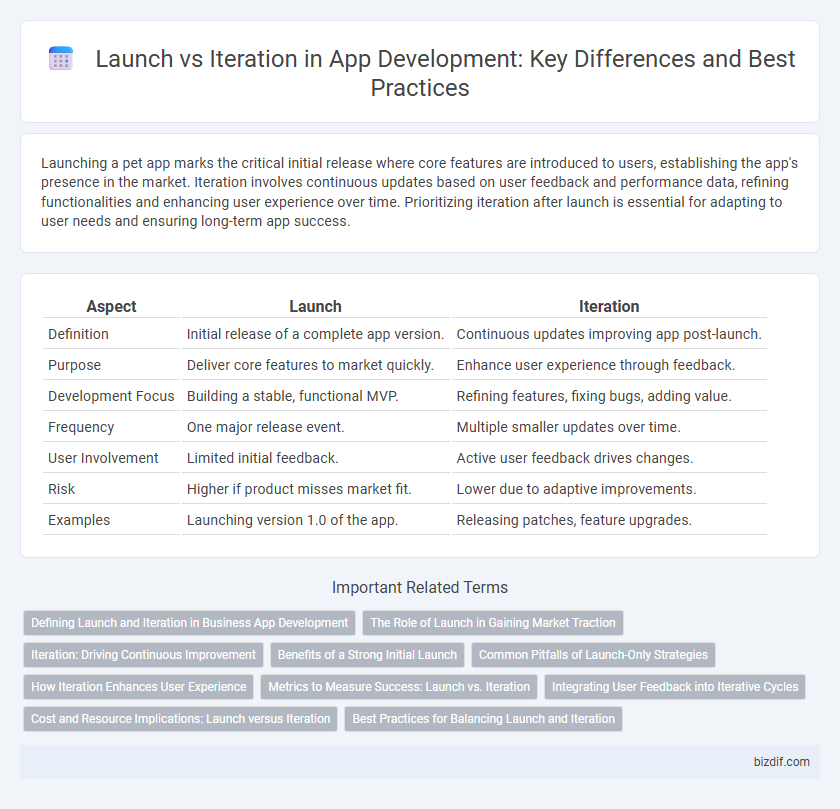Launching a pet app marks the critical initial release where core features are introduced to users, establishing the app's presence in the market. Iteration involves continuous updates based on user feedback and performance data, refining functionalities and enhancing user experience over time. Prioritizing iteration after launch is essential for adapting to user needs and ensuring long-term app success.
Table of Comparison
| Aspect | Launch | Iteration |
|---|---|---|
| Definition | Initial release of a complete app version. | Continuous updates improving app post-launch. |
| Purpose | Deliver core features to market quickly. | Enhance user experience through feedback. |
| Development Focus | Building a stable, functional MVP. | Refining features, fixing bugs, adding value. |
| Frequency | One major release event. | Multiple smaller updates over time. |
| User Involvement | Limited initial feedback. | Active user feedback drives changes. |
| Risk | Higher if product misses market fit. | Lower due to adaptive improvements. |
| Examples | Launching version 1.0 of the app. | Releasing patches, feature upgrades. |
Defining Launch and Iteration in Business App Development
Launch in business app development marks the initial release of a functional product to end-users, establishing a baseline for performance and user feedback. Iteration involves continuous refinement through updates and improvements based on user data, addressing bugs, enhancing features, and adapting to market changes. Prioritizing iterative cycles accelerates product evolution, ensuring alignment with user needs and business objectives over time.
The Role of Launch in Gaining Market Traction
Launching an app serves as a critical milestone for gaining initial market traction by enabling real user feedback and early adoption insights. The launch phase attracts attention from target audiences, validates product-market fit, and generates crucial usage data for subsequent iterations. Effective launch strategies accelerate user acquisition and establish a brand presence essential for iterative improvements and long-term success.
Iteration: Driving Continuous Improvement
Iteration in app development emphasizes continuous improvement by incorporating user feedback and data-driven insights to refine features and enhance performance. Frequent updates and rapid prototyping enable developers to address bugs, optimize user experience, and adapt to market demands swiftly. This agile approach ensures a responsive product lifecycle, increasing user engagement and retention over time.
Benefits of a Strong Initial Launch
A strong initial launch establishes immediate user trust and generates valuable feedback crucial for app optimization and growth. High-impact launches boost app store rankings, increasing visibility and organic downloads from targeted audiences. Early market traction also attracts investor confidence, accelerating further development and feature enhancements.
Common Pitfalls of Launch-Only Strategies
Relying solely on a launch-only strategy often results in limited user feedback, causing missed opportunities for critical improvements and feature enhancements that align with evolving customer needs. This approach increases the risk of market misfit, as initial assumptions may not accurately reflect real user behavior or preferences. Continuous iteration post-launch is essential to adapt to changing demands, fix unforeseen issues, and maintain long-term app success.
How Iteration Enhances User Experience
Iteration enhances user experience by enabling continuous improvements based on real user feedback, which leads to more intuitive interfaces and smoother functionality over time. Frequent updates refine app performance, address bugs quickly, and introduce features that align closely with user needs and preferences. This adaptive approach fosters higher user satisfaction and engagement compared to a one-time launch strategy.
Metrics to Measure Success: Launch vs. Iteration
Tracking user engagement, retention rates, and conversion metrics during the initial launch provides critical insights into market reception and functionality performance. Iterative cycles emphasize A/B testing results, user feedback scores, and feature adoption rates to refine app usability and optimize value propositions. Combining launch-phase quantitative data with iteration-driven qualitative analysis drives continuous improvement and maximizes long-term success.
Integrating User Feedback into Iterative Cycles
Integrating user feedback into iterative cycles accelerates app development by refining features based on real-world usage and preferences. Continuous iteration allows developers to address issues promptly, enhance user experience, and adapt to changing market demands effectively. This feedback-driven approach ensures higher user satisfaction and app performance compared to a one-time launch strategy.
Cost and Resource Implications: Launch versus Iteration
Launching an app requires significant upfront investment in design, development, testing, and marketing, often demanding substantial resources and budget allocation. Iterative development distributes costs over time by releasing incremental updates, allowing teams to optimize resource usage based on user feedback and performance data. Choosing iteration over a full launch minimizes financial risk and enables continuous enhancement, maximizing ROI through adaptive deployment strategies.
Best Practices for Balancing Launch and Iteration
Balancing launch and iteration in app development requires a strategic focus on minimum viable product (MVP) release, enabling early user feedback to inform iterative improvements. Implementing agile methodologies facilitates continuous deployment and testing, ensuring rapid adaptation to user needs and market changes. Prioritizing core features during launch while maintaining a robust backlog for iteration accelerates time-to-market and optimizes product evolution.
Launch vs Iteration Infographic

 bizdif.com
bizdif.com